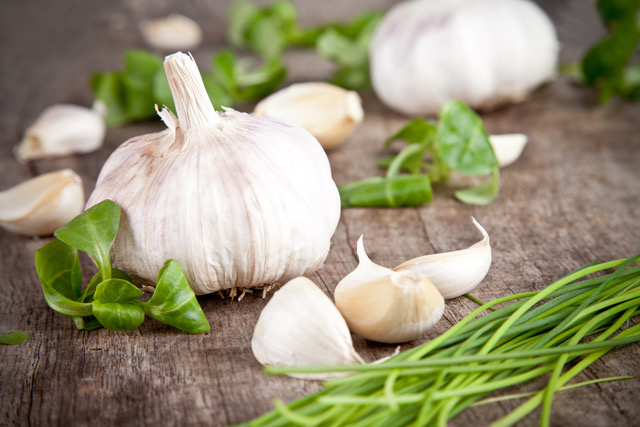Garlic Is A Powerful Superfood

Garlic’s claim to fame isn’t limited to warding off vampires. This small, pungent vegetable has numerous health benefits. It is high in Vitamin C, as well as B vitamins, manganese, selenium, iron, copper, and potassium. In addition to all those vitamins and minerals, garlic’s active ingredients allicin, alliin, and ajoene, help makes it a superfood.
To enjoy the biggest health benefits, it is best to eat fresh garlic. However, the beneficial chemical constituents in garlic are heat sensitive, so it is best to add the garlic at the end of food preparation, which leaves it almost raw. Two cloves a day is the minimal recommendation for enhancing health. However, eating raw or nearly raw garlic isn’t always practical for most people. As an encapsulated product, garlic can be consumed in standardized doses for therapeutic use. An enteric coated product can mitigate stomach upset in some people.
In botanical medicine, Garlic is most well known for it anti-bacterial, anti-viral, anti-fungal, and anti-parasitic actions. Acne, athlete’s foot, and MRSA are some conditions that may benefit from garlic (just keep in mind that topical garlic can cause irritation, so use it with great caution). Before antibiotics, it was used to treat chronic infections and to pack open wounds in order to prevent infection and sepsis. It was common to find garlic used on the battlefields from the time of the ancient Egyptians through WW1. In addition, the anti-viral and anti-bacterial actions of garlic make it a traditional oral remedy for preventing or quickly resolving colds and flus.
In ancient Chinese and Indian medicine garlic is considered a stimulating yang remedy, which is beneficial for increasing the appetite and improving symptoms of weakness. Garlic has historically been used as a blood stimulator. Today we better understand that garlic’s constituents give it potent anti-oxidant qualities, which supports this traditional use of the plant. Studies show that garlic can lower blood pressure, cholesterol levels, and improve microcirculation, all of which are beneficial for the heart.
The same anti-oxidants that help the circulatory system are thought to have anti-cancer benefits, as well. A wide variety of cancers responded positively to garlic. Of course, garlic is just one small nutritive component for overcoming cancer. Treatment for cancer usually requires a multipronged strategy to achieve success.
Overall, unless you have a food allergy or sensitivity, there are many good reasons to frequently consume this amazing little vegetable.
References:
https://www.ncbi.nlm.nih.gov/pmc/articles/PMC3249897/
https://www.ncbi.nlm.nih.gov/pmc/articles/PMC4211483/
https://www.ncbi.nlm.nih.gov/pmc/articles/PMC4250982/
Agarwal KC. Therapeutic actions of garlic constituents. Med Res Rev. 1996;16:111–24.
Dhawan V, Jain S. Garlic supplementation prevents oxidative DNA damage in essential hypertension. Mol Cell Biochem. 2005;275:85–94.
Reinhart KM, Coleman CI, Teevan C, Vachhani P, White CM. Effects of garlic on blood pressure in patients with and without systolic hypertension: a meta-analysis. Ann Pharmacother. 2008;42:1766–71.
Silagy C, Neil A. Garlic as a lipid lowering agent: a meta-analysis. J R Coll Physicians Lond. 1994;28:39–45.
Hassan HT. Ajoene (natural garlic compound): a new anti-leukaemia agent for AML therapy. Leuk Res. 2004;28:667–71.
Borek C. Garlic reduces dementia and heart-disease risk. J Nutr. 2006;136:810–2.


